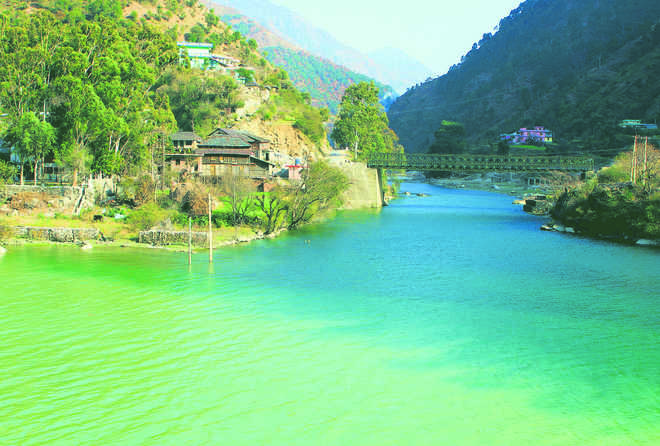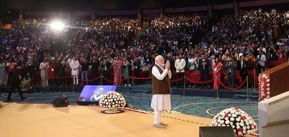
While we may laud these symbolic gestures for river preservation, as a society, we need to understand what a river actually means, what brought it into a crisis and what it takes to protect it. Tribune photos
Manshi Asher
The recent announcement of the Himachal Government to hold a ‘maha-arti’ to save the Beas comes close on the heels of the identification of the river as one of the seven critically polluted river stretches in Himachal by the Central Pollution Control Board in a report released in September 2018.
While we may laud these symbolic gestures for river preservation, as a society, we need to understand what a river actually means, what brought it into a crisis and what it takes to protect it.
One of the key features of a river is that it has to be free flowing, but the tragedy of the Beas (and its tributaries) is that its 286-km stretch stands dammed at various locations from Manali to Kangra. A total of close to 350 small, medium and large dams are in various stages of commissioning, construction and planning on this river.
Decades of damming
It was way back in 1974, that the Pong Dam was built on the Beas displacing close to 20,000 families, many of whom are yet to be rehabilitated. Soon after, the 990 MW Pandoh Dam, built on the border of Kullu and Mandi districts, diverted the waters of the Beas over 40 kms into the Sutlej to generate electricity.
Just below Pandoh Dam, the river completely dries up. Thanks to smaller tributaries including the Uhl, Binwa, Awa, Neugal, Luni flowing from the Kangra hills, the Beas comes alive again. However, three new projects — the141 MW Thana Palaun, 78 MW Triveni Mahadev and 66 MW Dhaulasidh project — are now proposed on this last stretch of the free-flowing Beas, between Pandoh and Pong dams.
If we turn our attention to the stretch between Manali and Pandoh, then there are the 192 MW Allain Duhangan and the 126 MW Larji projects. On Parbati, a crucial tributary of the Beas, is the 800 MW Parbati-II, which takes the waters of the Parbati near Barshaini and transfers it through a tunnel to the neighbouring Sainj river valley, where the 520 MW Parbati-III and the 100 MW Sainj project are located. These dams have caused immense ecological damage by blocking and tunnelling the river, a living ecosystem — a home for the endangered Himalayan trout and lower down for the Mahaseer. In fact, it is to protect the snow trout that the Tirthan River, also a tributary of the Beas, was declared a no-go area for hydro projects by the Himachal High Court, a few years ago, after local residents filed a petition. The government says it is holding the ‘maha-arti’ to raise awareness among people for the need to save the river, when actually these developments, be it dams or four-lane highways, which have dumped muck into the rivers causing high levels of siltation, are part of government policy, not demanded by people.
Denial of environmental impacts
The fact that the thrust for hydropower continues from the side of the state government is evident in the recent decisions taken by the Expert Appraisal Committee (EAC) of the Ministry of Environment and Forests (New Delhi), while examining the Cumulative Environment Impact Assessment report looking at the environmental feasibility of all future projects on the Beas River basin. If we examine the minutes of the meetings of the committee, we find that there were several projects that the EAC recommended to be dropped in its initial meetings, but later relented because of the insistence of the state government. For instance, the 21.9 MW Manalsu project, falling in Manali Wildlife Sanctuary, was recommended to be dropped, but the minutes of the November 27, 2018, meeting reveal that “the project has been considered on the request of the state government”. Similarly, the committee expressed its scepticism with regard to the 18 MW Raison project proposed to be constructed in an area that has several trout fishing sites. However, the state government got it pushed by saying that it had “newer” and “safer” technology to “minimalise” impacts. What matters gravely is that the state government was adamant that the environment flow (minimum release of water from the dam onto the river bed) should be maintained at 15 per cent, as per the Himachal Hydropower Policy 2006, rather than 20-25 per cent as proposed by the ministry and experts. It needs to be mentioned that the Cumulative Environment Impact Assessment study has not been made public for comments or consultation despite demands for the same.
It is not just the dams and the appropriation of the Beas water that is a problem. The Central Pollution Control Board report has shown that the stretch from Kullu to Dehragopipur is critically polluted exceeding permissible levels of Biological Oxygen Demand (BOD). Unregulated tourism and rapid urbanisation must be held responsible for this condition of the Beas. The number of tourists in Kullu-Manali alone went from 11,002 to 67,132 between 1975 and 1991. In 2016, this figure went up to 36 lakh. The Kullu, Bhuntar and Manali municipalities have failed to check pollution in the Beas due to sewage, solid waste and trash from resorts.
Redefining development
Not all crises can be pinned down to local factors. Climate change is depleting the Himalayan glaciers. A study of satellite images shows that Parbati glacier, in the Beas river basin, has retreated by 578 metres between 1990 and 2001, a decline of almost 52 metre per year.
Only a major policy shift could possibly pull the Beas out of the crisis it has been pushed to. This would definitely mean moving away from projects that lead to deforestation and pollution of the river. More river stretches need to be left free flowing like the Tirthan. The laws are already in place, but monitoring agencies including the Pollution Control Board, Fisheries Department and the Irrigation and Public Health need to be strengthened. Over the years, their roles have become redundant to ensure least hindrance to ‘project developers’. In this regard, amendments in the Hydropower Policy of 2006, which were made in 2014 and 2016, need to be withdrawn, as these dilute the process of getting the No Objection Certificates from these departments as well as affected villages prior to approval of hydro projects. Strengthening of governance by involving communities through local bodies, in planning and management is essential. Environment flows (e-flow), though only talk of maintaining minimum flows in the river as against natural free flow, need to be ensured in the operational hydropower projects. Several scientists have proposed a minimum e-flow of 25 to 30 per cent for a river to be called a ‘river’ in the first place.
The state’s narrative around ‘saving a river’ has proved to be inadequate, as we have seen in the case of the Ganga, where a whole ministry was set up to rejuvenate and clean the river with crores of investment under the ‘Namami Gange’ programme without much result. The BJP-led Himachal Government attempting to initiate the worship of the ‘Beas’ along the lines of ‘Ganga’ is unlikely to change the status quo.
(The author is an environmental researcher-activist with Himdhara)



























